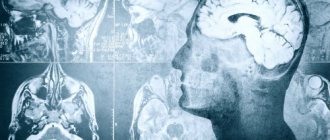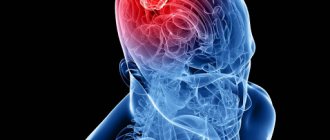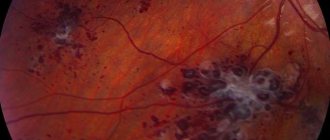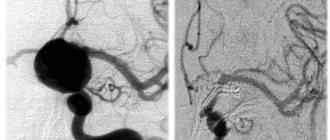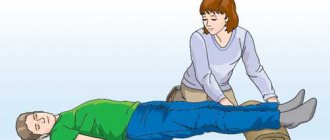These may be causes directly affecting the brain (trauma, neurotropic viruses, toxins), or factors associated with secondary lesions (blood or vascular diseases that lead to starvation of neurons and inhibition of their activity, endocrine diseases, brain tumors and etc.).
What is organic damage to the nervous system?
Organic damage to the central nervous system
- a pathological condition in which the brain does not function fully. The lesion can be congenital or appear due to trauma, stroke, infectious diseases of the brain, alcoholism and drug addiction.
Lesions are divided into grades 1-3. Stage 1 lesions are diagnosed in many people; they do not manifest themselves in any way and do not require treatment. Lesions of degrees 2 and 3 interfere with normal life and can provoke more dangerous diseases, so they need to be treated.
Organic brain damage – relationship with functional disorders
Historically, earlier in psychiatry, all mental illnesses were divided into organic (in which the substrate can be identified - the site of the lesion, the cause of the process) and functional (which are caused exclusively by social and behavioral factors).
However, with the development of medicine, this division lost its relevance and showed that exclusively organic and exclusively functional disorders are rarely encountered.
For example, post-traumatic stress disorder (PTSD) used to be considered purely functional, since its cause was the direct fact of suffering mental trauma. Now it has been proven that the emergence and development of PTSD is associated not only with the presence of mental trauma, but also with certain characterological characteristics of the individual, including those of an organic nature, the so-called. pathoplastic basis (organic lesions at the subclinical level, preceding the manifestation of PTSD, such as post-infectious processes, trauma during childbirth, etc.).
Modern instrumental studies have now proven that patients with panic disorder exhibit diencephalic insufficiency.
According to G.L. Voronkov, there are practically no organic mental disorders in their pure form; they are always a combination and interpenetration of organic and functional symptoms.
How does organic damage to the nervous system manifest and what is dangerous?
When the central nervous system is damaged, the following symptoms are observed:
- fast fatiguability;
- impaired coordination, inability to perform simple movements and actions because of this;
- problems with hearing, vision;
- inability to concentrate on a task, the need to constantly be distracted;
- trouble sleeping, insomnia, nightmares or constant awakenings;
- urinary incontinence;
- decreased immunity, which often causes colds and other diseases.
Brain lesions are especially dangerous for children who are lagging behind in physical development and cannot study normally and communicate with peers. Also, lesions lead to oligophrenia, that is, mental retardation, and dementia - loss of skills and knowledge, and the inability to acquire new ones.
Degenerative diseases of the central nervous system: general concepts
The main characteristics of the group of degenerative diseases of the central nervous system are the following criteria:
- diseases begin unnoticed; before their appearance, the nervous system could function absolutely normally;
- diseases have a gradually progressive course and can last for years or decades;
- some degenerative diseases are associated with hereditary factors and develop in several members of the same family;
- a neurodegenerative disease of the central nervous system is characterized by the gradual death of neurons and their replacement by glial elements;
- atrophic processes at the initial stage of pathology development occur in a specific area of one of the cerebral hemispheres; further, during the advanced stage of degeneration, atrophy in the brain becomes almost symmetrical.
Various diseases of the central nervous system, the list of which is quite long, remain under study. The reasons for the occurrence of atrophic processes during the normal functioning of the nervous system for most of a person’s life are not reliably known. However, there are a number of factors that can trigger brain degeneration:
- alcohol abuse, drug addiction;
- toxic effects of pesticides and herbicides;
- meningococcal infection;
- viral encephalitis;
- deficiency of vitamin B12 and folic acid.
Advantages of treating central nervous system lesions in our clinic
- We accept adults and children
. We enroll adult patients and preschool children. We send young patients to a doctor who specializes in brain damage in children. - We treat children in the presence of parents
. If a child experiences fear or anxiety, we conduct a consultation in the presence of the parents. If necessary, we carry out further treatment in front of the parents to reduce stress for the child. - We select therapy individually
. We assess the degree of damage, the presence of concomitant diseases and disorders. We select treatment taking into account the patient’s age, general health, and response to previous therapy. - We warn you about the duration of treatment and possible results
. We will tell you how long the treatment can last, since organic lesions require long-term therapy. We predict how effective the therapy will be in a particular case, and discuss this with the patient.
To make an appointment with a doctor, call or use the feedback form. The administrator will call you back, answer questions and help you choose a convenient appointment time.
Infectious diseases of the central nervous system
Infectious diseases of the central nervous system are among the most common neurological pathologies. CNS diseases caused by infection are very dangerous. They have a severe course, leave serious consequences and significant neurological deficits. Infectious diseases of the central nervous system can be caused by bacteria, viruses, and fungal diseases. Most often, diseases develop when meningococcus, staphylococcus, pneumococcus, ECHO and Coxsackie enteroviruses, mumps, and candida enter the body. The entry gates for infection are the ENT organs; it is also transmitted by contact, hematogenous, lymphogenous, and perineural routes.
The infection can affect the nervous system as a primary disease or occur secondarily as a result of the development of an infectious process outside the central nervous system. Infectious diseases of the central nervous system include:
- meningitis,
- encephalitis,
- polio,
- syphilis of the nervous system,
- toxoplasmosis of the nervous system,
- neurological manifestations of HIV infection,
- parasitic diseases of the nervous system.
What is brain damage?
Organic brain damage is primarily a symptom of a disease, manifested by disruption or loss of a number of functions as a result of the pathogenic effect of some factor on brain tissue. The etiology of brain damage can be very diverse, and this will be discussed in more detail later in the article. Organic damage means that brain cells - neurons - are exposed to a variety of influences, which lead to the formation of dystrophic processes inside neurons and disrupt their functional activity. In the most serious cases, neurons simply undergo first necrobiosis and then necrosis, i.e. are dying. The death of a large number of neurons localized in a single anatomical space leads to the loss of one or another function in the body of the affected person, and the identification of a disturbed function allows specialists to understand in which part of the brain the catastrophe occurred - this is called topical diagnostics. Symptoms of organic brain damage in children manifest themselves differently than in adults, since the full activity of the higher nervous system has not yet been formed. Children may experience delays in mental, mental and physical development, unstable mood and behavioral abnormalities.
Pathogenetic mechanisms of neuronal damage
A number of mechanisms of different nature can lead to organic damage to the brain. This pathological condition can be provoked by both external and internal factors, and this must be taken into account, since therapeutic measures, depending on the pathogenetic type of development of damage to brain neurons, will differ radically.
Violation of energy supply
The most common pathogenetic variant of brain damage is associated with an imbalance between the need of neurons for energy and its entry into the cell. Energy deficiency can develop due to insufficiency:
- Nutrients in the victim's body, for example as a result of hypoglycemia, when there is not enough glucose in the blood;
- Oxygen, which causes a condition such as hypoxia. Brain hypoxia causes damage to nervous tissue and often occurs in acute ischemic or hemorrhagic cerebrovascular accidents. In children, brain hypoxia can develop in the antenotal period and during childbirth, which leads to anoxic brain damage in the child.
- When the concentration of potassium, calcium, sodium and chlorine ions increases or, conversely, excessively decreases, transmembrane proteins may malfunction, which also entails energy deficiency inside the cell.
It is worth noting that energy deficiency leads to rapidly progressive damage to brain tissue and within 5-7 minutes, in the absence of sufficient oxygenation, neurons begin to experience acute hypoxia and die. Damage to the blood vessels of the brain has the following symptoms:
- The patient notes memory impairment;
- There is a decrease in vision and hearing;
- The synthetic activity of the brain slows down;
- When performing angiography of cerebral vessels, multiple stenoses of cerebral vessels can be detected;
- MRI of the brain shows dystrophic disorders and a decrease in the volume of the cerebral cortex.
All of the above symptoms are signs of systemic atherosclerosis, which affects most older people. Atherosclerosis leads to the formation of discirculatory encephalopathy.
Traumatic injuries
Injuries are always associated with mechanical damage to the brain and the subsequent development of edema, which leads to an increase in intracranial pressure. Since the brain is located in the cranium and literally floats in the cerebrospinal fluid - intracerebral fluid, the consequences of blows and bruises become serious. Despite. The cerebrospinal fluid plays a protective and shock-absorbing role; with the development of a brain contusion, an increase in intracranial pressure occurs, since the fluid is not physically compressible. Brain cells are exposed to excessive pressure and begin to die. Brain tissues occupy up to 96% of the volume of the cranial cavity, which makes this organ very sensitive to changes in intracranial pressure.
It is very important to note that quite often injuries are accompanied by internal hemorrhage, which can lead to the formation of an extensive hematoma and displacement of the brain. Dislocation of the brain leads to wedging of its subcortical structures into the foramen magnum, which inevitably leads to the death of neurons located in the nuclei of the vasomotor and respiratory centers, without which the life of the victim is impossible.
Infectious
Brain damage can be caused not only by physical factors. But also biological. Conditions such as meningitis, encephalitis, and ventriculitis can significantly impair the functional activity of the brain.
- Meningitis is an inflammation of the lining of the brain. Etiological factors can be very diverse, so the brain can be affected by many bacterial and viral diseases. Inflammation of the membranes of the brain can occur primarily through direct infection through the wound gate. And secondarily – as a result of an immunodeficiency state.
- Encephalitis is inflammation of the brain tissue itself. Encephalitis is an even more severe infectious disease than meningitis. As a result of encephalitis, purulent melting and liquefaction of areas of the brain can occur, which leads to the formation of persistent disturbances in the functioning of various organs of the victim. With encephalitis, brain damage very often leads to disability or even death.
- Ventriculitis is an inflammation of the integumentary tissues lining the ventricles of the brain. This disease occurs in newborns and infants and leads to increased intracranial pressure and the development of hydrocephalus due to insufficient drainage function of the cerebrospinal fluid.
The brain can be affected by both specific and nonspecific infectious agents; this is important to consider when prescribing treatment, since antibacterial therapy regimens will vary.
Congenital pathology
Anomalies of brain development can form in the very early stages of a child’s development. The first trimester of pregnancy is the most dangerous for the woman and the fetus, since the pregnant woman’s body and the fetus are unprotected from external factors, and at the time of the initiation and formation of organs, the most dangerous anomalies and gross developmental pathologies can form, for example micro or acephaly.
Toxic damage
Not the most common type of brain damage, but nevertheless it does occur. Brain damage occurs if the chemical has neurotoxic properties and is able to cross the blood-brain barrier. Neurotoxic agents lead to organic damage in various parts of the nerve cell; most often, neurons suffer from disruption of the transmembrane transfer of nutrients and disturbances in the synthesis of neurotransmitters. Toxic injuries of varying severity can lead to both persistent encephalopathy and complete loss of some functions of the person affected by intoxication. Most often, gross organic damage to the brain is caused by substances such as arsenic and nitrogen metabolism products, with excessive accumulation of the latter in the blood plasma.
Oncological diseases
Brain damage in oncology can be primary. When a tumor develops directly from brain tissue or secondary - when atypical tumor cells are metastatically introduced into the brain.
Features of the course of pathology in childhood
The development of children with organic brain damage has some features and differs from that of their peers. Specialists and parents of children almost always face difficulties in education and training, since some functions may correspond to the age period or even be ahead of it, while others are seriously lagging behind. In this regard, the child’s behavior may not seem entirely correct - he does not obey, gives the impression of being ill-mannered and uncontrollable, gets tired quickly, may be too stubborn, inattentive, irritable, etc.
Timely diagnosis of organic brain damage makes it possible to work with such children purposefully, providing not only psychological and pedagogical support, but also medicinal support. If there is no diagnosis as such, then the psychologist’s task is to exclude organic pathology as the cause of behavioral characteristics or learning difficulties.
Children with organic brain damage have so-called damaged mental development, which includes relatively mild changes and disorders of moderate severity (minimal brain dysfunction, disorder of interhemispheric interactions), as well as conditions that indicate severe brain pathology - epilepsy, progressive disorder of the central nervous system with deep disorders of psycho-speech and motor development.
Minimal brain dysfunction is a mild degree of brain dysfunction, when learning abilities are reduced and there are some behavioral abnormalities. The prerequisites for the formation of this pathology in children are:
- Impact of harmful factors on a pregnant woman (gestosis, infections, intoxication, ethanol, medications, etc.);
- Birth injuries;
- Diseases, especially infectious ones, in the first 3 years of a baby’s life.
The listed factors can cause focal changes in the cortex and subcortex, which are characterized by an extreme variety of symptoms and are determined by the localization of the lesion. The most characteristic signs of minimal brain dysfunction are motor disorders:
- Awkward or excessive movements;
- Teak;
- Motor hyperactivity or severe slowness;
- Grimaces;
- Uncontrollable behavior.
These symptoms gradually decrease as the child grows, and with the right approach to educational activities and therapy in a teenager, they can be completely unnoticeable, unless they are discovered during an examination by a neurophysiologist or an EEG analysis.
In the case of unfavorable circumstances, such as injuries, operations, diseases of internal organs, infections, overwork, an unfavorable psychological climate in the family, the signs of brain damage deepen, and then minimal changes will turn into psychopathy, neuroses, convulsive syndrome, severe speech impairment, autism.
Due to the risk of worsening brain dysfunction with even mild organic damage, it is important for specialists to promptly identify children with disabilities and refer them for observation and treatment by a neurologist, for consultation with a psychologist, speech therapist, or defectologist.
Other manifestations of organic brain damage such as minimal dysfunction and cerebrasthenia are detected through a standard psychiatric examination. Patients have:
- Rapid mental fatigue and exhaustion;
- Reduced attention;
- Difficulty remembering;
- Uneven development of mental abilities when performing special tests (indicates against mental retardation);
- Emotional instability;
- Sensitivity to the assessment of a testing teacher or doctor.
Some patients with minimal impairments have age-appropriate development of personal qualities, while intellectual capabilities, memory, and learning are somewhat delayed. Such children worry about their inadequacy, are prone to stuttering, phobias, sleep disorders, tics, suffer from low self-esteem and are very responsive to the attitude and evaluation of people significant to them.
If the development of the volitional sphere and emotions is disrupted, then over time a psychopathic-like disorder may form, which will manifest itself in excessive excitability, emotional lability, touchiness, and irascibility. Patients with psychopathic-like syndromes are prone to such behavioral disorders as vagrancy, aggression, excessive sexual desire and attempts to realize it. Criticism of oneself and actions is reduced, self-esteem is inadequate.
The difference between a psychopathic-like syndrome and typical psychopathy is mental disorder and uneven underdevelopment of intelligence. Through research, it is possible to determine the exact location of the site of organic brain damage, which is especially important after injuries to the skull and central nervous system.
Interhemispheric dysfunction is a disorder in the development of one of the hemispheres of the brain or the interaction between the hemispheres. A patient with predominant activity of the right hemisphere may be left-handed with an unusual perception of the environment, figurative and symbolic thinking, while logical constructs, abstractions, and precise data are not easily perceived. In the first grades, difficulties appear with mathematics, lexical and grammatical analysis of sentences.
“Right-hemisphere” children have normal memory, attention, they are efficient, they remember visual images well in all details, they think as if in pictures, but the construction of logic and the search for patterns suffer greatly. The use of visual images and associations can significantly facilitate the learning process, therefore in elementary school it is important for the teacher not to concentrate on the standard program, but to make maximum use of visual aids, draw and encourage independent drawing of diagrams, tables, etc.
“Left-hemisphere” children, on the contrary, do poorly on tasks that involve the use of visual analysis. They have correct speech, read and write well, have logic, but may suffer from underdevelopment in the emotionally sensitive area.
Severe forms of organic brain damage are accompanied by profound disorders of speech, writing, and reading, which interfere with learning at school. It is important to teach such patients to recognize the emotions of others and express their own, and analyze the actions of others. Music, drawing, and special training have a beneficial effect on the development of the psyche. In adolescence, difficulties may arise when communication with peers gives way to the computer or spending time at home.
Vascular diseases of the central nervous system
Poor circulation in the brain provokes the development of vascular diseases of the central nervous system. These pathologies are extremely dangerous because in most cases they lead to disability. Also, vascular diseases of the central nervous system have a high mortality rate. Brain damage occurs as a result of ischemic and hemorrhagic strokes, transient ischemic attacks, and spontaneous subarachnoid hemorrhages. The causes of such pathologies are:
- aneurysms,
- thromboembolism,
- vascular atherosclerosis,
- hypertonic disease,
- acute toxic damage to the walls of blood vessels,
- chronic degenerative diseases of the walls of blood vessels.
The trigger for the development of strokes can be severe stress, seizures, alcohol intoxication, and sudden changes in body temperature. Vascular disease of the central nervous system most often occurs spontaneously and requires immediate medical attention.
